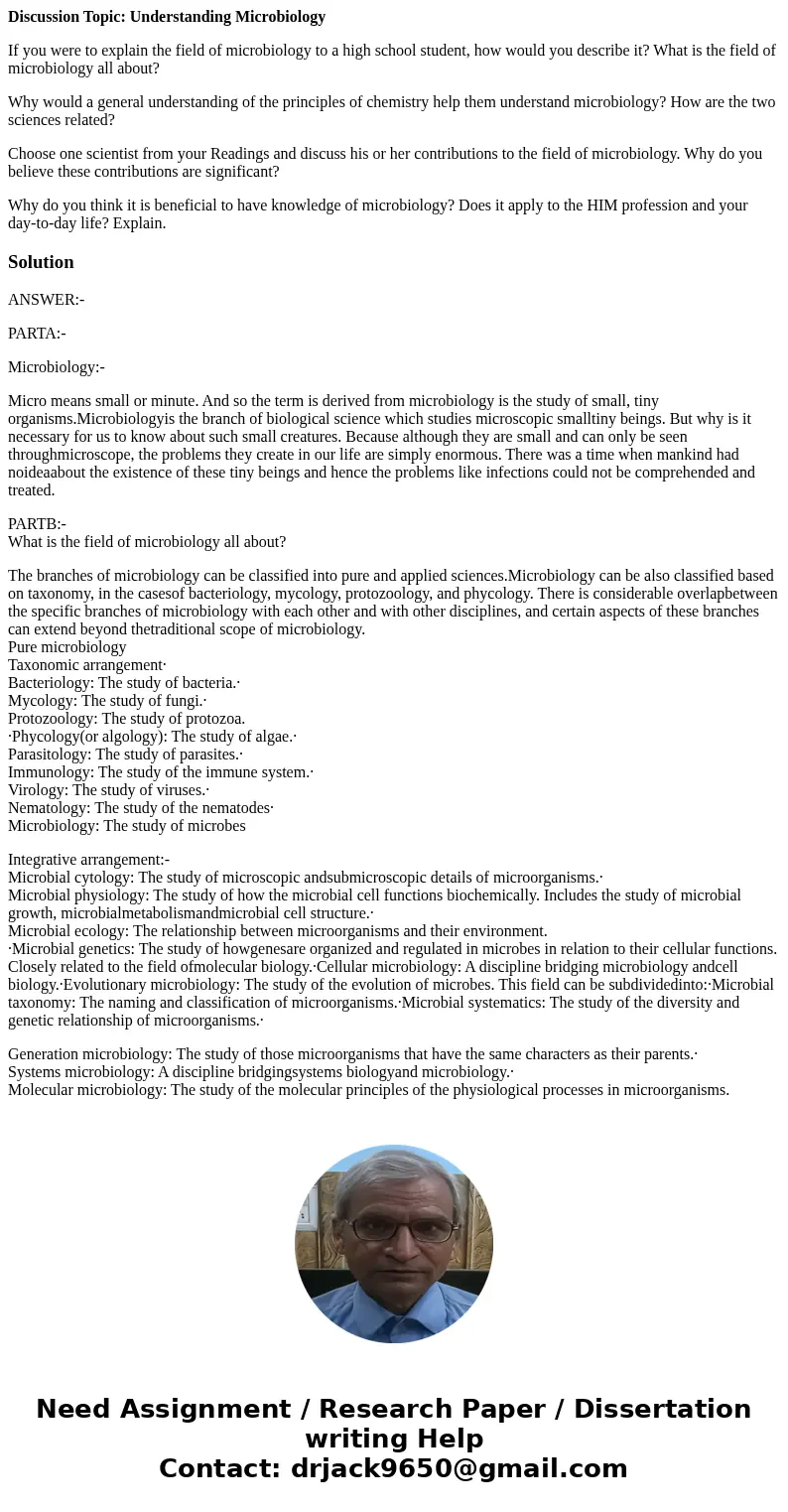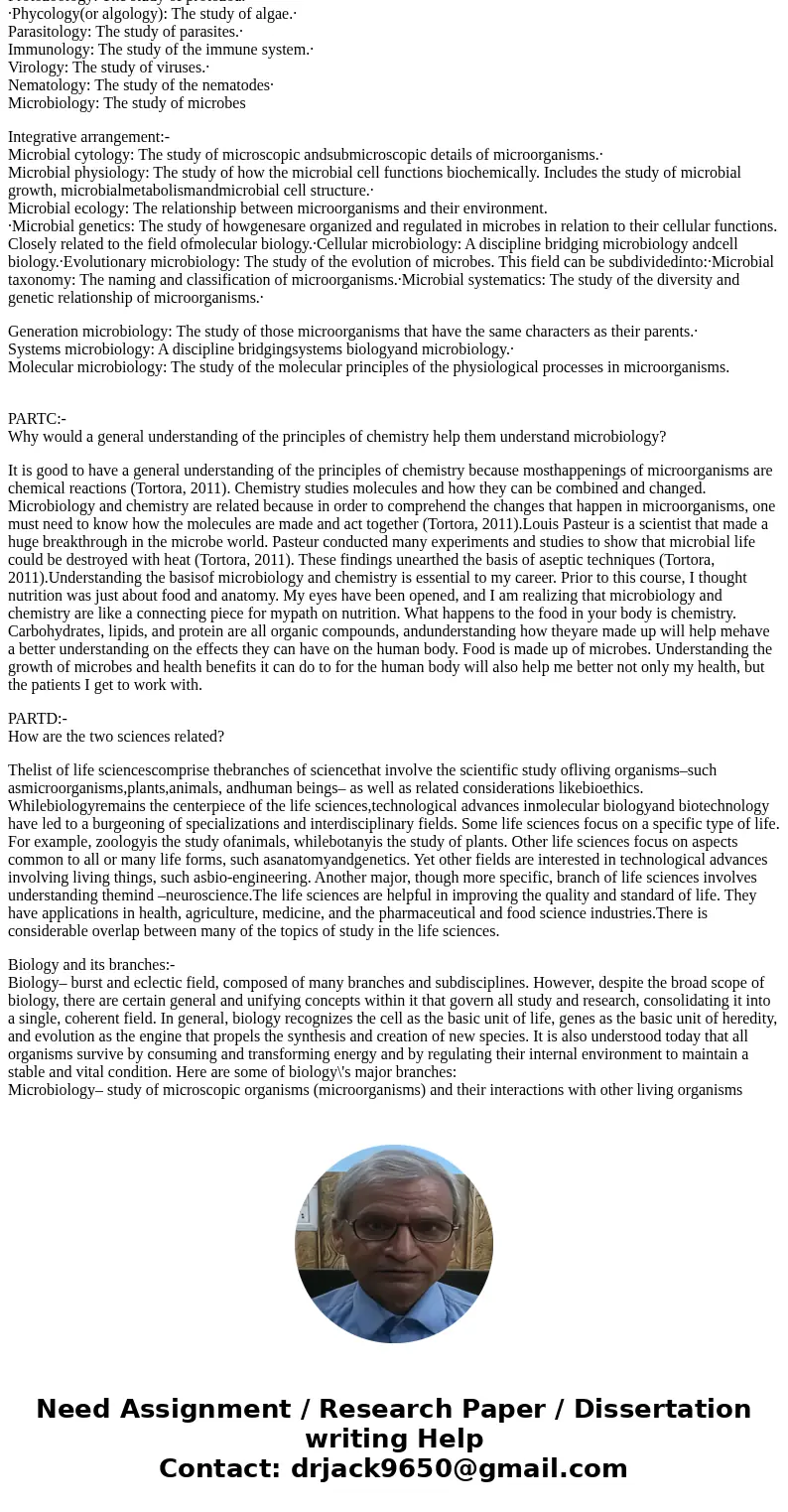Discussion Topic Understanding Microbiology If you were to e
Discussion Topic: Understanding Microbiology
If you were to explain the field of microbiology to a high school student, how would you describe it? What is the field of microbiology all about?
Why would a general understanding of the principles of chemistry help them understand microbiology? How are the two sciences related?
Choose one scientist from your Readings and discuss his or her contributions to the field of microbiology. Why do you believe these contributions are significant?
Why do you think it is beneficial to have knowledge of microbiology? Does it apply to the HIM profession and your day-to-day life? Explain.
Solution
ANSWER:-
PARTA:-
Microbiology:-
Micro means small or minute. And so the term is derived from microbiology is the study of small, tiny organisms.Microbiologyis the branch of biological science which studies microscopic smalltiny beings. But why is it necessary for us to know about such small creatures. Because although they are small and can only be seen throughmicroscope, the problems they create in our life are simply enormous. There was a time when mankind had noideaabout the existence of these tiny beings and hence the problems like infections could not be comprehended and treated.
PARTB:-
What is the field of microbiology all about?
The branches of microbiology can be classified into pure and applied sciences.Microbiology can be also classified based on taxonomy, in the casesof bacteriology, mycology, protozoology, and phycology. There is considerable overlapbetween the specific branches of microbiology with each other and with other disciplines, and certain aspects of these branches can extend beyond thetraditional scope of microbiology.
Pure microbiology
Taxonomic arrangement·
Bacteriology: The study of bacteria.·
Mycology: The study of fungi.·
Protozoology: The study of protozoa.
·Phycology(or algology): The study of algae.·
Parasitology: The study of parasites.·
Immunology: The study of the immune system.·
Virology: The study of viruses.·
Nematology: The study of the nematodes·
Microbiology: The study of microbes
Integrative arrangement:-
Microbial cytology: The study of microscopic andsubmicroscopic details of microorganisms.·
Microbial physiology: The study of how the microbial cell functions biochemically. Includes the study of microbial growth, microbialmetabolismandmicrobial cell structure.·
Microbial ecology: The relationship between microorganisms and their environment.
·Microbial genetics: The study of howgenesare organized and regulated in microbes in relation to their cellular functions. Closely related to the field ofmolecular biology.·Cellular microbiology: A discipline bridging microbiology andcell biology.·Evolutionary microbiology: The study of the evolution of microbes. This field can be subdividedinto:·Microbial taxonomy: The naming and classification of microorganisms.·Microbial systematics: The study of the diversity and genetic relationship of microorganisms.·
Generation microbiology: The study of those microorganisms that have the same characters as their parents.·
Systems microbiology: A discipline bridgingsystems biologyand microbiology.·
Molecular microbiology: The study of the molecular principles of the physiological processes in microorganisms.
PARTC:-
Why would a general understanding of the principles of chemistry help them understand microbiology?
It is good to have a general understanding of the principles of chemistry because mosthappenings of microorganisms are chemical reactions (Tortora, 2011). Chemistry studies molecules and how they can be combined and changed. Microbiology and chemistry are related because in order to comprehend the changes that happen in microorganisms, one must need to know how the molecules are made and act together (Tortora, 2011).Louis Pasteur is a scientist that made a huge breakthrough in the microbe world. Pasteur conducted many experiments and studies to show that microbial life could be destroyed with heat (Tortora, 2011). These findings unearthed the basis of aseptic techniques (Tortora, 2011).Understanding the basisof microbiology and chemistry is essential to my career. Prior to this course, I thought nutrition was just about food and anatomy. My eyes have been opened, and I am realizing that microbiology and chemistry are like a connecting piece for mypath on nutrition. What happens to the food in your body is chemistry. Carbohydrates, lipids, and protein are all organic compounds, andunderstanding how theyare made up will help mehave a better understanding on the effects they can have on the human body. Food is made up of microbes. Understanding the growth of microbes and health benefits it can do to for the human body will also help me better not only my health, but the patients I get to work with.
PARTD:-
How are the two sciences related?
Thelist of life sciencescomprise thebranches of sciencethat involve the scientific study ofliving organisms–such asmicroorganisms,plants,animals, andhuman beings– as well as related considerations likebioethics. Whilebiologyremains the centerpiece of the life sciences,technological advances inmolecular biologyand biotechnology have led to a burgeoning of specializations and interdisciplinary fields. Some life sciences focus on a specific type of life. For example, zoologyis the study ofanimals, whilebotanyis the study of plants. Other life sciences focus on aspects common to all or many life forms, such asanatomyandgenetics. Yet other fields are interested in technological advances involving living things, such asbio-engineering. Another major, though more specific, branch of life sciences involves understanding themind –neuroscience.The life sciences are helpful in improving the quality and standard of life. They have applications in health, agriculture, medicine, and the pharmaceutical and food science industries.There is considerable overlap between many of the topics of study in the life sciences.
Biology and its branches:-
Biology– burst and eclectic field, composed of many branches and subdisciplines. However, despite the broad scope of biology, there are certain general and unifying concepts within it that govern all study and research, consolidating it into a single, coherent field. In general, biology recognizes the cell as the basic unit of life, genes as the basic unit of heredity, and evolution as the engine that propels the synthesis and creation of new species. It is also understood today that all organisms survive by consuming and transforming energy and by regulating their internal environment to maintain a stable and vital condition. Here are some of biology\'s major branches:
Microbiology– study of microscopic organisms (microorganisms) and their interactions with other living organisms


 Homework Sourse
Homework Sourse